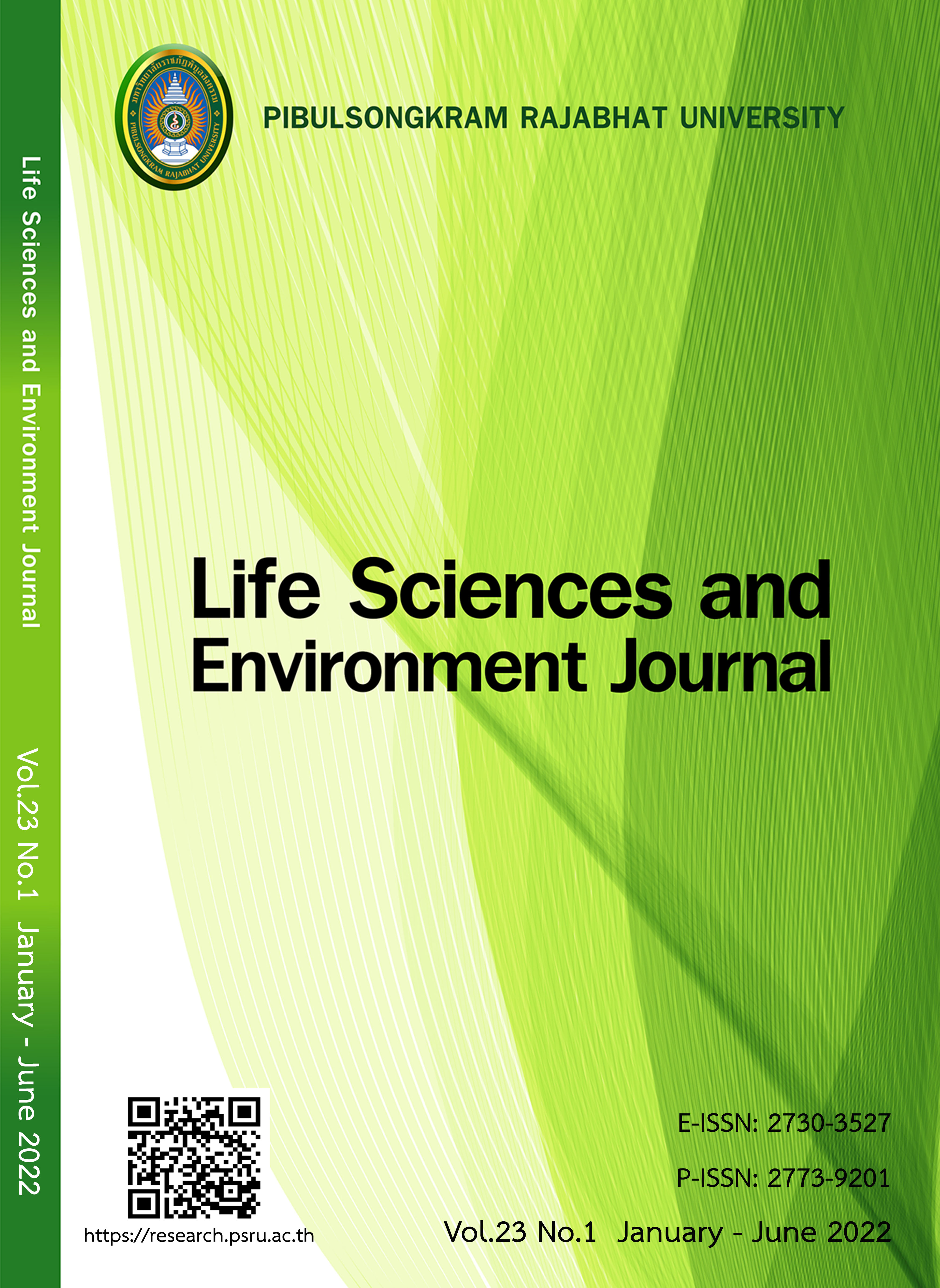PHYSICOCHEMICAL PROPERTIES AND NUTRITIONAL VALUES OF REDUCED-SUGAR GALANGA JELLY FROM GALANGA ROOT EXTRACT
DOI:
https://doi.org/10.14456/lsej.2022.11Keywords:
Galanga, Jelly, Sucralose, Maltitol, SweetenerAbstract
This research aimed to study the physicochemical properties and nutritional values of reduced sugar galanga sugar jelly from galanga root extract. Sweetness of sucrose was replaced by sucralose and maltitol at 0%, 50%, 75%, and 100%. The results showed that increasing the levels of sucralose and maltitol tended to increase the lightness (L*), whereas redness (a*) and yellowness (b*) values were decreased (p≤0.05). The 100% maltitol sweetener showed the lowest hardness, springiness, and chewiness compared to other formulations. The moisture content was in a range of 23.80-28.79%. For total bacteria, yeast and mold, Coliform, E. Coli, Salmonella and S. aureus test, the jelly was in accordance with the standard of Thai community. Sensory evaluation showed that galanga jelly with 100% maltitol gained the highest consumer acceptance scores of 7.22, which was not significantly different (p>0.05) from the control. The nutritional values of the developed jelly product were also investigated; the percentages of protein, lipid, ash, and carbohydrate were 5.47%, 0.01%, 0.09%, and 43.48%, respectively. The total calorie of this product was 2,919.23 cal/g.
References
AOAC. Official method 966.23. Microbiological methods first action 1966 final action 1989, Maryland; 1989.
AOAC. Official method 991.14 coliform and Escherichia coli counts in foods dry rehydratable film (Petrifilm™ E. coli/Coliform Count PlateTM and Petrifilm™ Coliform Count PlateTM) Methods First Action 1991 Final Action 1994, Maryland; 1994.
AOAC. Official methods of analysis. Maryland: The Association of official analytical chemists, Maryland; 2000.
AOAC, Official Method 2014.01. Salmonella in selected foods 3MTM PetrifilmTM Salmonella express system first action 2017 final action 2017, Maryland; 2017.
AOAC. Official Method 2014.05. Enumeration of yeast and mold in Food 3M™ Petrifilm™ rapid yeast and mold count plate first action 2014, Maryland; 2014.
Arlai A, Pongchanla S, Chanthipwong S. The development of low-calorie foy-thong with sugar alcohol. The 10th NPRU National Academic Conference, 29-30 March, 2018, Nakhon Pathom, Thailand; 2018.
Bansri AM, Taha H, Ahmad N. A Review on the pharmacological activities and phytochemicals of Alpinia officinarum (Galangal) Extracts Derived from Bioassay-Guided Fractionation and Isolation. Pharmacognosy Reviews 2017;11(21):43-56.
Basu S, Shivhare US, Singh TV. Effect of substitution of stevioside and sucralose on rheological, spectral, color and microstructural characteristics of mango jam. Journal of Food Engineering 2013;114:465-476.
Chen CS. Relationship between water activity and freezing point depression of food systems. Journal of Food Science 1987;52(2):433-435.
Churasri A. Benefits of eating galangal. 2020. Available at: www.medium.com. Accessed January 28, 2021.
Dobreva V, Hadjikinova M, Slavov A, Hadjikinov D, Dobrev G, Zhekova B. Functional properties of maltitol. Agricultural Science and Technology 2013;5(2):168-172.
Kearsley MW, Deis RC. 13 Maltitol powder. In O’Donnell K, Kearsley MW. (Eds.), sweeteners and sugar alternatives in food technology. Oxford: Blackwell Publishing; 2006: 295-308.
Köse LP, Gülc I, Gören AC, Namiesnik J, Martinez-Ayala AL, Gorinstein S. LC–MS/MS analysis, antioxidant and anticholinergic properties of galanga (Alpinia officinarum Hance) rhizomes Leyla. Industrial Crops and Products 2015;74:712-721.
Lees R, Jackson EB. Gums, jellies and pastilles. In Lees R, Jackson EB. (Eds.), Sugar confectionery and chocolate manufacture. London: Chapman & Hall;1973:226-265.
Lin SD, Hwang CF, Yeh CH. Physical and sensory characteristics of chiffon cake prepared with erythritol as replacement for sucrose. Journal of Food Science 2003;68(6):2107-2110.
Mahae N, Chaiseri S. Antioxidant activities and antioxidative components in extracts of Alpinia galanga (L.) Sw. Kasetsart Journal Natural Science 2009;43:358-369.
Norsuwan T, Tantechai S. Effect of maltitol on physical and chemical properties of low-calorie passion fruit jam. The 56th Kasetsart University Annual Conference, 6-9 February, 2018, Bangkok, Thailand; 2018.
Periche A, Heredia A, Escriche I, Andrés A, Castelló ML. Optical, mechanical and sensory properties of based-isomaltulose gummy confections. Food Bioscience 2014;7:37-44.
Rittilert P, Warin K. Development of karanda (Carissa carandas L.) Gummy Jelly Product. Thai Journal of Science and Technology 2020;9(2):342-354.
Roze M, Crucean D, Diler G, Rannou C, Catanéo C, Jonchère C, Le-Bail A, Le-Bail P. Impact of maltitol and sorbitol on technological and sensory attributes of biscuits. Foods 2021;10(11):1-15.
Rozzi NL. Sweet facts about maltitol. Food product design. 2007. Available at: https://talcottlab. tamu.edu/wp-content/uploads/sites/108/2019/01/Maltitol.pdf. Accessed February 2, 2021.
Schiffman SS, Rother KI. Sucralose, A synthetic organochlorine sweetener: Overview of biological issues. Journal of Toxicology and Environmental Health, Part B: Critical Reviews 2013;16(7):399-451.
Silbernagel KM, Jechorek RP, Carver CN, Horter BL, Lindberg KG. 3MTM PetrifilmTM Staph express count plate method for the enumeration of Staphylococcus aureus in selected dairy foods: collaborative study. Food Biological Contaminants 2003;86(5):963-970.
Siwavej S. Food additives (Vol. 1). Nakhon Pathom: National agricultural extension and training center kamphaengsaen campus of Kasetsart University; 2003.
Struck S, Jaros D, Brennan CS, Rohm H. Sugar replacement in sweetened bakery goods. International Journal of Food Science and Technology 2014;49(9):1963-1976.
Supimarot S. The technology of candy and chocolate production. Bangkok: Cu Press; 2000.
Vamanon M, Sapcharoen P. Local vegetables. Bangkok: Department of Medical Services; 1995.
Vasiliki E, Maria M, Ioanna M, Michael K. Compression of gellan gels. Part II: Effect of sugars. Food Hydrocolloids 2010;24(4):392-397.
Zhou YQ, Liu H, He MX, Wang R, Zeng QQ, Wang Y, Ye WC, Zhang QW. A Revies of the botany, phytochemical, and pharmacological properties of galangal. In Grumezescu AM, Holban AM (Eds.), Natural and Artificial Flavoring Agents and Food Dyes A volume in Handbook of Food Bioengineering MA: Academic Press; 2018: 351-396.
Downloads
Published
How to Cite
Issue
Section
License
Copyright (c) 2022 Life Sciences and Environment Journal

This work is licensed under a Creative Commons Attribution-NonCommercial-NoDerivatives 4.0 International License.
Each article is copyrighted © by its author(s) and is published under license from the author(s).










